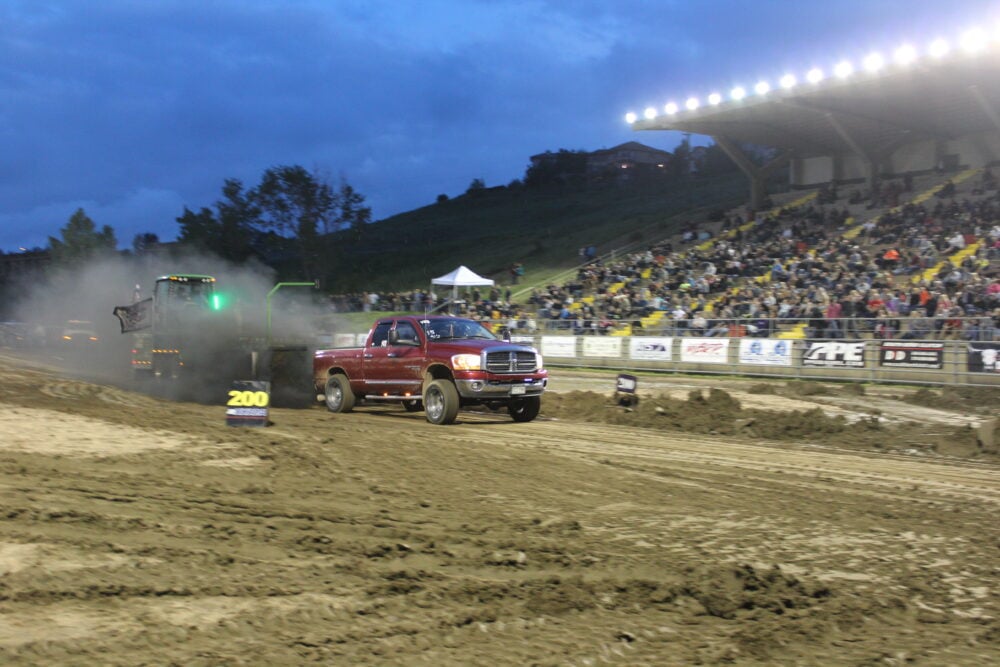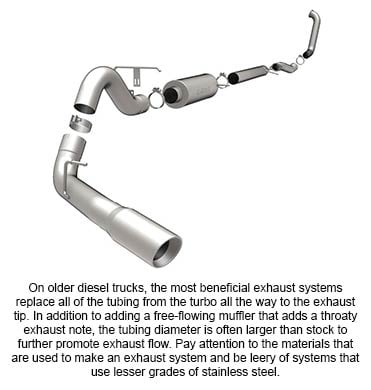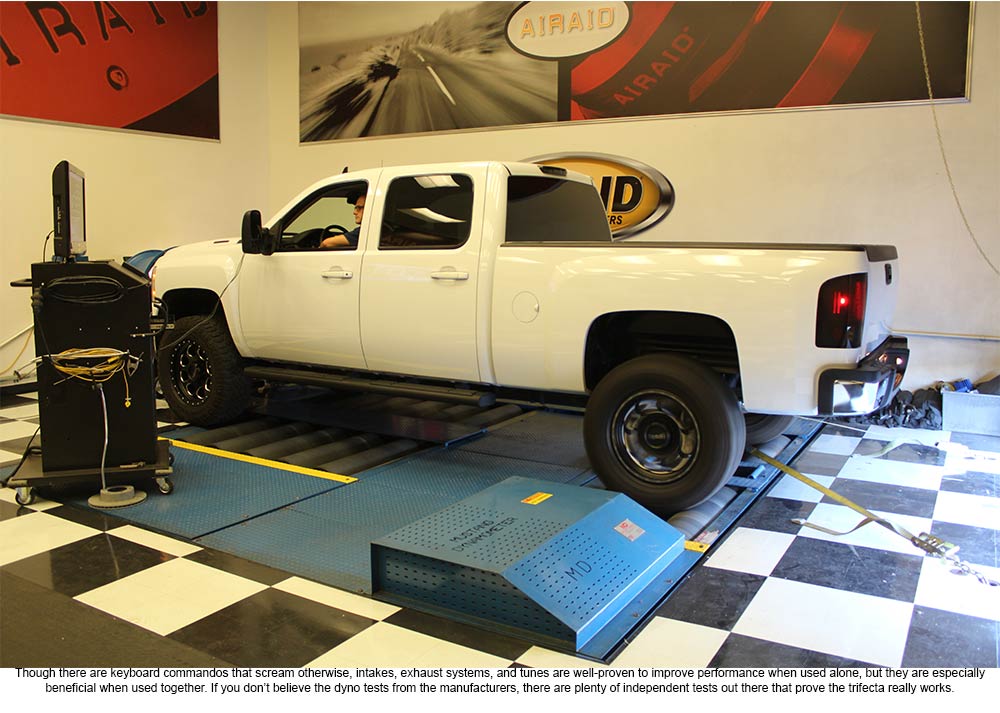Maybe you’ve just purchased your first diesel, or maybe you’ve had a diesel for a while and have noticed you’ve been getting out-pulled on the grades by similar trucks with similar loads. Maybe you want to improve your truck’s performance, or maybe you’re after more fuel economy. Regardless of the situation, there comes a time in every self-respecting diesel owner’s life that they want to start upgrading their truck. It’s not cool getting smoked by your friend’s truck at a light, and nobody likes slowing down on those hills. Luckily, there are a host of products available in the aftermarket that can make enormous differences in power and fuel economy. So many, in fact, that it’s hard to tell where to start. We’re here to help save your truck from stock, and regardless of what make or model of diesel you happen to own, we recommend starting with the trifecta: Intake, Exhaust, and Tune. These three simple modifications can unlock reasonable amounts of power when used by themselves, but when used together, they can completely transform a truck.
The Power Principle
An engine is essentially a giant air pump. It draws in outside air, compresses and injects fuel for ignition, then exhales the spent gasses. In an ideal world there would be no restriction to an engine inhaling air and exhaling exhaust, but in reality engines are noisy, and diesels especially so. To keep the noise down, OE manufacturers install various baffles and mufflers to both sides of the engine to keep the noise down, but all of those noise-canceling properties come at the expense of power and performance. Then there’s the control of fuel and various other functions, which on modern vehicles is all done by computer. OEMs tend to be very conservative on engine controls for various reasons, including fuel economy, longevity, noise, and so on.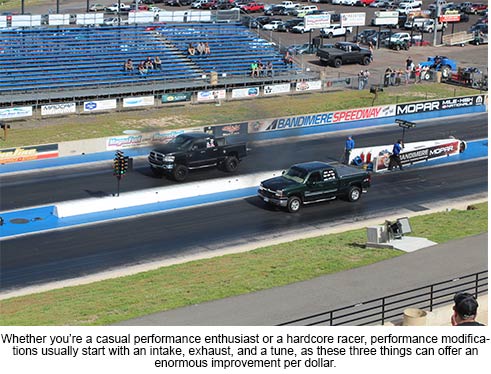
Eliminating restrictions on the intake and exhaust is easy enough to understand. An intake involves installing a high-flow air filter and larger diameter intake ducting that draws in cool outside air and smooths the path to the engine. An exhaust involves freeing up the path for spent gases to exit the engine. These things enable the engine to run more efficiently, which equates to more power along with better fuel economy. All of the extra flow means the engine can handle more fuel and a more aggressive fuel map from an aftermarket tuner, which in turn enables the turbo to spool quicker and results in even more power. The trifecta – intake, exhaust, and tune – works because each individual modification enables the other one to work even better than they could alone. This is why adding all three modifications is a great combination for making power, and this has been proven time and again in magazines, dyno tests, and independent shops all over the world.
Now that we understand why the trifecta works, let’s take a closer look at the different features and benefits available from popular intake systems, exhaust systems, and tuners. We’re not going to recommend any specific brand or style; the goal here is to explain the major differences so that you as a buyer can make more educated buying decisions.
Suck It Up
Though Cold Air Intake (CAI) Systems have been around for many years, there are inevitable naysayers that will claim they don’t do anything and aren’t worth the money. Most of these people hide behind a keyboard and lack any sort of factual basis for their claims other than what they’ve heard and read elsewhere (usually on the internet) from similar parrots that may or may not even own a diesel truck. Very few have any practical real-world experience and hide behind the anonymity of a screen name and 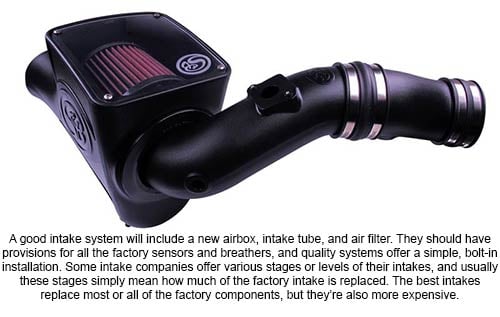 cite evaluations with dubious test practices performed by people with equally dubious intentions. While there are certainly occasional tests that claim Cold Air Intakes make little, if any, power, there are hundreds more out there with proven, repeatable, and verifiable results. The overwhelming consensus is that Cold Air Intakes do make power, and this is especially true with diesels.
cite evaluations with dubious test practices performed by people with equally dubious intentions. While there are certainly occasional tests that claim Cold Air Intakes make little, if any, power, there are hundreds more out there with proven, repeatable, and verifiable results. The overwhelming consensus is that Cold Air Intakes do make power, and this is especially true with diesels.
A diesel engine needs an enormous amount of air to run efficiently. They place extreme demands on the filter used to capture debris as well as the path that outside air must take to reach the cold side of the turbo. As mentioned earlier, OE manufacturers will put various baffles in the intake tract in order to keep noise down (which hurts airflow) and they often use undersized paper filter elements that further hamper airflow. Factory intake boxes are typically funneled to a single intake duct that draws in air, but the inlet is often in an area that allows hot engine compartment to be drawn into the engine. All of these things hurt power and fuel efficiency.
A good CAI system does three things: it replaces any restrictive portions of the factory intake system (including the intake box and tube), it replaces the paper filter element, and it increases the amount of cool outside air that reaches the engine. The first two are easy enough to understand, but why is cold air important? Cold air is denser than hot air, meaning that cold air packs more oxygen molecules. Oxygen is critical to combustion, so the more oxygen that reaches 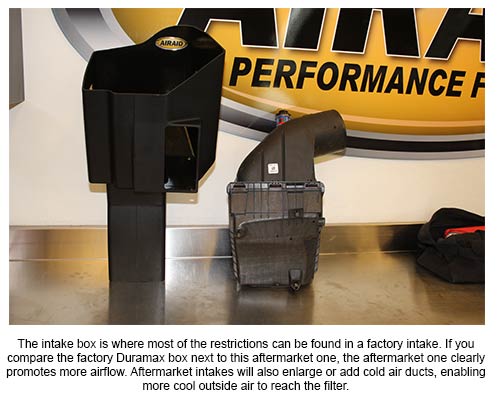 the combustion chambers, the more complete the combustion cycle will be. Better combustion means more power and greater efficiency. In addition to cold air, quality intake systems will include a new intake tube that smooths airflow to the turbo and a high-flow filter element that further improves airflow without introducing restrictions. Performance filters work by using premium washable filter media and then increasing the surface area of the filter media. This is why the cone filters used with most intake systems are so much larger than the factory flat panel filters. Most of these filter materials offer the same filtration properties as stock filters as well, so there’s no danger of the engine sucking in harmful particles. Aftermarket paper filters work off of the same principle of increased surface area compared to a stock filter.
the combustion chambers, the more complete the combustion cycle will be. Better combustion means more power and greater efficiency. In addition to cold air, quality intake systems will include a new intake tube that smooths airflow to the turbo and a high-flow filter element that further improves airflow without introducing restrictions. Performance filters work by using premium washable filter media and then increasing the surface area of the filter media. This is why the cone filters used with most intake systems are so much larger than the factory flat panel filters. Most of these filter materials offer the same filtration properties as stock filters as well, so there’s no danger of the engine sucking in harmful particles. Aftermarket paper filters work off of the same principle of increased surface area compared to a stock filter.
So what sorts of things should a buyer be looking for in a cold air intake system? As we mentioned before, intakes that replace the factory intake box and intake tube are good, along with systems that increase the ability for cool outside area to reach the filter. This is usually done with additional ducting that pulls air from areas ahead of the core support or behind the front bumper. Intake tubes should have provisions for all of the factory sensors and breathers, and the overall system should offer a simple, bolt-in installation. Don’t be afraid of intake systems that work with the factory tuning, as this indicates that the system is properly designed and positions various sensors where they need to be in order to get good readings on the incoming air. In fact, it’s not a bad idea to be leery of systems that require a tune. Many of these are full-blown race systems that really aren’t designed for street use, or systems that developers haven’t spent the engineering time needed to make sure everything works as it should. As with many things, you get what you pay for; quality name-brand intakes might be more expensive than cheap no-name ebay or Amazon versions, but those name-brand intakes have the engineering behind them to ensure they will work properly along with a warranty that will cover issues should they arise.
Perhaps the biggest decision to make regarding Cold Air Intakes is which type of filter to use. There are basically three types: oiled filters, dry filters, and paper filters. Each type has its advantages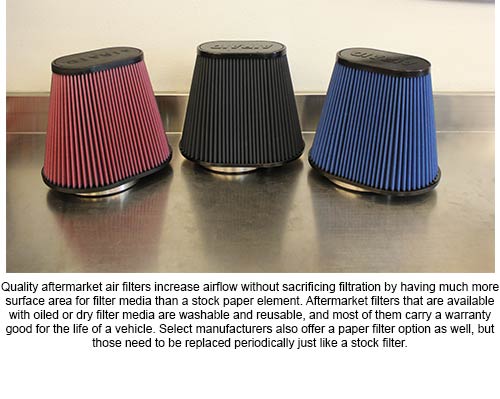 and disadvantages, and the proper filter for a particular application largely boils down to individual preferences and uses.
and disadvantages, and the proper filter for a particular application largely boils down to individual preferences and uses.
Traditional oiled performance filters include layers of cotton gauze protected by a wire mesh screen. The oiled filters will generally go longer between cleanings than a dry filter, but the oiling process makes servicing an oiled air filter slightly more difficult and messy. Oiled filters also have occasional concerns about the oil messing up sensors, but this is almost always due to improper servicing and the user grossly over-oiling the filter. In fact, the largest performance filter manufacturer in the world, K&N, did an extensive study and produced and interesting video on mass air sensor contamination that’s worth a watch (search for it on Youtube) if sensor contamination concerns you. Oiled filters are washable and reusable, and with proper care are good for the life of the vehicle.
Dry filters also have a wire mesh screen like oiled filters, but instead of cotton gauze, dry filters will have multiple layers of synthetic materials that eliminate the need for oiling. Some manufacturers will tout a certain number of layers used in their filters and imply that more layers equals better filtration, but reality is that filtration quality has more to do with what those individual layers consist of rather than the number of layers. Dry filters require less maintenance during the cleaning because they don’t require oiling, but dry filters do need to be serviced more often as they have a tendency to pack up with dirt quicker than their oiled equivalents. For this reason, many experienced shops will recommend against using a dry filter in really dirty, dusty environments. Like oiled filters, dry filters are washable and reusable.
Though not quite as exciting as the other types, paper filters are a third viable option. Paper eliminates the filtration quality concerns because paper filters use the same media as most factory flat panel filters. Though paper media is more likely to introduce restrictions, intake companies counteract those restrictions by increasing the surface area of the filter itself compared to factory. More surface area means more air can travel through the media before restrictions develop. The big downside to paper filters is that they are not serviceable and must be replaced periodically. Though service intervals depend a lot on the operating environment, paper filters will last somewhere in between when an oiled and dry filter need servicing. Since the paper filter is not stock, this also means the filter can’t be picked up at a local auto parts store when a replacement is needed.
Now that we’ve examined Cold Air Intakes, let’s move to the other side of the engine. After being routed from the engine and through that magical snail-shaped device that boosts power, spent exhaust gasses need an efficient way to exit the vehicle. Just like the intake, there are various resonators and mufflers positioned in the exhaust to reduce noise, but these also introduce airflow restrictions that hurt power and performance. Reducing or eliminating those restrictions therefore improves engine performance and even fuel economy. These reductions come from things such as installing larger diameter tubing, removing resonators, and installing free-flowing mufflers. All of these are relatively simple bolt-on operations that can make real improvements, especially when coupled with an intake and a tune.
In the case of late-model diesels, things have become a lot more complicated with exhaust systems in recent years. Significant emissions devices have been added to diesel trucks over the last decade, including catalytic converters, Diesel Particulate Filters (DPFs) and urea 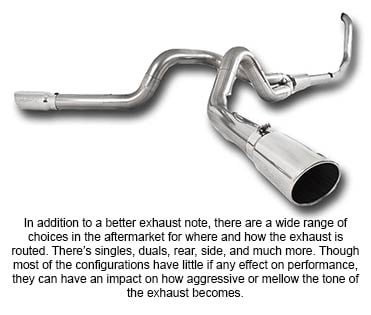 injection systems. As one might expect, these emissions devices do introduce varying degrees of restrictions to the system. Unfortunately for diesel enthusiasts, tampering with or removing these systems in against federal law, and those states that have emissions inspections are usually looking for those devices to be present. As a result, legal exhaust modifications are not quite as effective as a turbo-back system on an older truck, but gains are still possible with aftermarket performance exhaust systems on even the newest trucks.
injection systems. As one might expect, these emissions devices do introduce varying degrees of restrictions to the system. Unfortunately for diesel enthusiasts, tampering with or removing these systems in against federal law, and those states that have emissions inspections are usually looking for those devices to be present. As a result, legal exhaust modifications are not quite as effective as a turbo-back system on an older truck, but gains are still possible with aftermarket performance exhaust systems on even the newest trucks.
Aside from performance benefits, another thing to consider with an aftermarket exhaust system is its construction and the materials used. As mentioned earlier, any exhaust that is larger in diameter than the factory system is going to have more airflow capability, so stepping up from a 3-inch diameter exhaust to a 4-inch or 5-inch system is going to be beneficial. When available, it’s a good idea to install a system that replaces everything from the turbo back, as opposed to a cat-back system. There are some legal aftermarket high-flow catalytic converters on the market, and as aftermarket technology advances, there’s a chance that performance DPFs may one day exist. A free-flowing muffler will 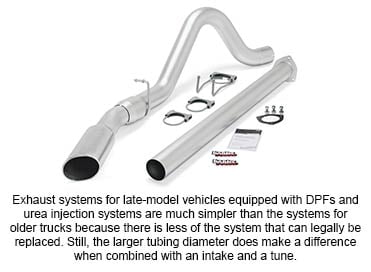 always be beneficial while also giving your truck that throaty exhaust note that every enthusiast wants.
always be beneficial while also giving your truck that throaty exhaust note that every enthusiast wants.
When comparing exhaust systems, pay close attention to the materials used. Certain low-quality grades of stainless steel can rust very quickly in certain parts of the country, so be aware that stainless systems which use something other than 304 have the potential for discoloration and corrosion. In most cases, we’ve actually had better luck with exhaust systems that use aluminized tubing instead of stainless, especially in parts of the country with harsh winters and the associated road chemicals. In most cases a fully welded muffler will outlast one with pinch seams, and ones with internal baffles will outlast ones that are packed with noise-canceling material that breaks down over time. Fit and finish can vary among exhaust systems, but it has been our experience that fit is generally very good with the larger, more 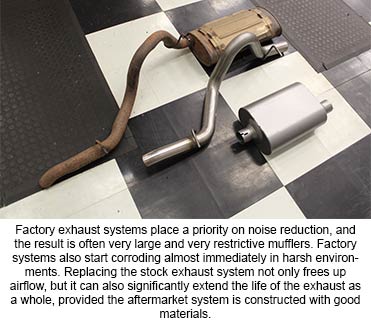 popular brand names. Regardless of how mild or radical you get with an exhaust system, make sure that the system you install complies with the emissions laws present in your state.
popular brand names. Regardless of how mild or radical you get with an exhaust system, make sure that the system you install complies with the emissions laws present in your state.
Get Your Geek On
The last piece of the trifecta is technically the most complicated of the three, yet it’s generally the easiest to install. Sometimes called a chip or programmer, a performance tune involves modifying many different factory settings in order to improve performance. These modifications can include fuel delivery and timing, boost pressures, rev limiters, and much more. The programming behind a tuner is extremely complicated and can take thousands of hours to develop. Done properly, a performance tune can yield substantial performance increases, but done improperly, they can cause severe engine damage. This is among the reasons why it’s important to stick with a name-brand tuner and stay away from the cheap knock-offs on bargain sites. A tune usually makes the most dramatic difference of the three as a stand-alone performance improvement that you can feel from the seat, but like the others, a tune can build off of the benefits of an intake a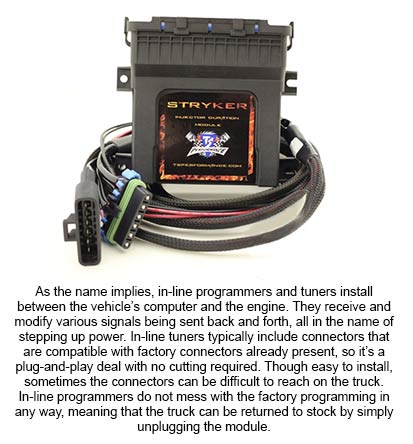 nd an exhaust system to produce more power than it would by itself.
nd an exhaust system to produce more power than it would by itself.
Though there are many different tuners with a wide range of features out there, they basically fall into one of two categories. An in-line tuner installs between the truck’s ECM and the engine. It takes the signals going back and forth between the sensors and the computer and modifies them to increase performance. An integrated tuner removes the factory tuning software from the PCM and replaces it with a different tune, again, to enhance performance. The critical difference between the two is that the in-line tuner does not in any way change the factory programming, so if for any reason the truck needs to be returned to stock, it’s a simple matter of unhooking the tuner and the truck will be just as it left the factory. With an integrated tune, you’re relying on the tuner to re-install the factory tuning in the event that the truck is returned to stock, and this process leaves a detectable footprint within the computer that the vehicle manufacturer will be able to see. This footprint could have significant factory warranty ramifications, which is important if maintaining the factory warranty is a priority.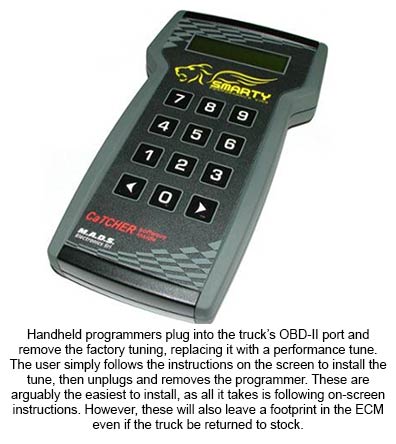
Aside from the performance tune itself, many tuners offer a dash-mounted display and have many other useful features. Some offer several different levels of performance, from a tow / haul mode that boosts low-end torque, to a drag-racing tune that bumps up boost and fuel delivery in order to extract maximum performance. Select tuners can be updated via the internet and even have specialty tunes geared toward specific intake or exhaust packages. Several offer functions that allow you to keep tabs on engine vitals such as boost and EGTs, can re-program your speedometer to correct for larger tires and / or a gear ratio change, and even retrieve and clear trouble codes. Of course, the more features that are available, the more expensive the tuner can be. Aside from sticking with a reputable manufacturer, it’s best to determine what features are important to you and then see what works with your budget.
Let’s Wrap It Up
Hopefully now you have a better understanding of what the trifecta consists of and why it can be so beneficial for a diesel truck’s performance. As we wrap things up, there’s one final piece of the puzzle to consider should you have a truck that is still under warranty. Dealerships can vary wildly in their attitude towards aftermarket equipment. While some dealers have a more progressive attitude 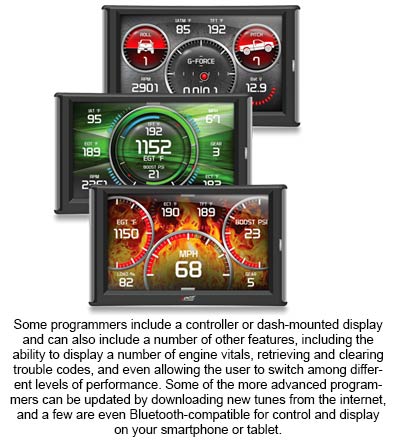 towards aftermarket modifications, others are ridiculous to the point of breaking the law in denying warranty claims simply because aftermarket components are present. Here are the facts: The Magnusson-Moss Act is a federal law that specifically prohibits a manufacturer from denying a warranty claim simply because of the presence of aftermarket equipment. Further, if they deny a warranty claim, the burden is on the manufacturer, not the consumer, to prove that an aftermarket part led to the direct failure of the factory components. This is the same law that protects your right to use things like oil filters and tires from somewhere other than a dealer or manufacturer. As stated, there are many dealers around the country that understand the laws and are pro-aftermarket, sometimes even selling accessories right out of their own parts department. Unfortunately, there are also a few hard-liners out there that will try to claim your truck’s aftermarket intake voids the entire powertrain warranty. It’s important to understand your rights and how the modifications you are considering will affect your vehicle’s warranty. We always strongly recommend talking to your dealer and seeing where they stand on certain modifications. If you find one that’s close-minded, try another dealership. With a little research you can usually find a dealer in your area that’s willing to work with your build plans, especially with the relatively mild modifications we’re covered here.
towards aftermarket modifications, others are ridiculous to the point of breaking the law in denying warranty claims simply because aftermarket components are present. Here are the facts: The Magnusson-Moss Act is a federal law that specifically prohibits a manufacturer from denying a warranty claim simply because of the presence of aftermarket equipment. Further, if they deny a warranty claim, the burden is on the manufacturer, not the consumer, to prove that an aftermarket part led to the direct failure of the factory components. This is the same law that protects your right to use things like oil filters and tires from somewhere other than a dealer or manufacturer. As stated, there are many dealers around the country that understand the laws and are pro-aftermarket, sometimes even selling accessories right out of their own parts department. Unfortunately, there are also a few hard-liners out there that will try to claim your truck’s aftermarket intake voids the entire powertrain warranty. It’s important to understand your rights and how the modifications you are considering will affect your vehicle’s warranty. We always strongly recommend talking to your dealer and seeing where they stand on certain modifications. If you find one that’s close-minded, try another dealership. With a little research you can usually find a dealer in your area that’s willing to work with your build plans, especially with the relatively mild modifications we’re covered here.
One last subject that we haven’t touched on much is emissions laws. As we stated earlier, it is against federal law to defeat or remove 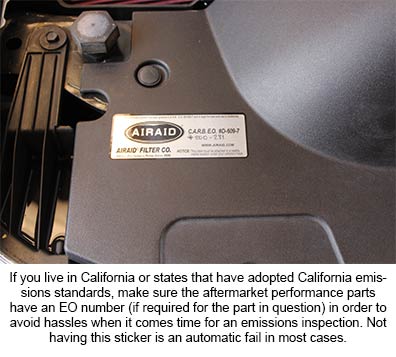 factory emissions equipment, and many states have emissions inspections with trained officials that can tell whether or not emissions equipment is in place. Make sure you understand what the laws are in your state before you dive into making modifications. California is the strictest on emissions, but they also have a program in place that can certify aftermarket modifications as emissions-compatible. Products that have been evaluated and tested are given an Executive Order (EO) number that makes them legal for use and sale on California-registered vehicles. Many other states have piggy-backed on California’s program and also accept products with EO numbers as legal. Intakes require an EO number, while exhaust systems do not provided they only replace items after the catalytic converter or other emissions devices present. Tuners also require EO numbers, but finding 50-state-legal tuners is difficult. Tuners with EO numbers will often have more limited functions and features. But with the exception of tuners, don’t make the mistake of thinking that a product with an EO number is somehow less effective than another product without one. An EO number simply means that the manufacturer of the product has expended the time and expense to have the product certified by California’s program. Not all manufacturers have the resources to do that, or they simply choose not to go through the process. Instead, an EO number can be viewed as a sign of quality because you know that the product in question was engineered well enough to improve performance without impacting the vehicle’s emissions in any way. Also remember that in most cases, it’s fairly easy to remove an intake, exhaust modification, or tune should the truck need to be returned to stock for any reason.
factory emissions equipment, and many states have emissions inspections with trained officials that can tell whether or not emissions equipment is in place. Make sure you understand what the laws are in your state before you dive into making modifications. California is the strictest on emissions, but they also have a program in place that can certify aftermarket modifications as emissions-compatible. Products that have been evaluated and tested are given an Executive Order (EO) number that makes them legal for use and sale on California-registered vehicles. Many other states have piggy-backed on California’s program and also accept products with EO numbers as legal. Intakes require an EO number, while exhaust systems do not provided they only replace items after the catalytic converter or other emissions devices present. Tuners also require EO numbers, but finding 50-state-legal tuners is difficult. Tuners with EO numbers will often have more limited functions and features. But with the exception of tuners, don’t make the mistake of thinking that a product with an EO number is somehow less effective than another product without one. An EO number simply means that the manufacturer of the product has expended the time and expense to have the product certified by California’s program. Not all manufacturers have the resources to do that, or they simply choose not to go through the process. Instead, an EO number can be viewed as a sign of quality because you know that the product in question was engineered well enough to improve performance without impacting the vehicle’s emissions in any way. Also remember that in most cases, it’s fairly easy to remove an intake, exhaust modification, or tune should the truck need to be returned to stock for any reason.
In closing, there are a lot of choices out there when it comes to an intake, exhaust, or a tune for just about any diesel truck. The selection can often get overwhelming, so if you have any questions, one of our sales representatives is happy to walk you through the wide variety of products available on our website. But once you have a trifecta installed on your truck, you’ll be blown away by the difference it can make to your truck.

